The Carbonate System of Penzhina Bay and the Shelikhov Gulf in the Sea of Okhotsk during Extreme Tides in Summer
Abstract
1. Introduction
2. Materials and Methods
2.1. Object
2.2. Field Work, Hydrological Surveys, and Water Sampling
2.3. Laboratory Analysis
2.4. Calculation of the FCO2 at the Water/Atmosphere Boundary
2.5. Software
3. Results
3.1. The Spatial Variability of Salinity and Temperature
3.2. Spatial Variability of the Carbonate System Parameters
3.3. Variability of the Carbonate System Parameters by Salinity
3.4. Daily Variability in Salinity, Temperature, and Carbonate System Parameters
3.5. Distribution of Nutrients as a Factor for Primary Production Intensification and an Accompanying Response of the Carbonate System
4. Discussion
4.1. Tidal Effects
4.2. Response of the Carbonate System to the Production/Destruction Balance of OM
4.3. CO2 flux in the Water/Atmosphere System and the Potential Effect of Wind Conditions on its Intensity
4.4. Comparison with Other Coastal Areas and Estuaries
5. Conclusions
- The dominance of primary production is accompanied by CO2 undersaturation relative to the atmosphere throughout the water column of Penzhina Bay, except for a small part at its head, down to a depth of about 60 m, with a water salinity of less than 22 psu. As a consequence, the water in the main part of the basin absorbs CO2 from the atmosphere, while its water is a source of CO2 for the atmosphere. This distribution is observed regardless of the time of day, as solar illumination persists for almost 24 h a day at this latitude at this time of year.
- In the Shelikhov Gulf, in the area above the central canyon, influenced by tidal mixing, the lowest pCO2 values were found for the entire region under study, which are associated with the dominance of primary production despite the supply of additional CO2 from the deep waters in this area.
- The TA and DIC depend almost strictly on salinity, with correlation coefficients higher than 0.99, while the pH value almost mirrors this with its dependence on the pCO2 and is determined by a combination of factors: the balance of the production/destruction of organic matter and the buffer capacity of the water, which is determined by its alkalinity.
Supplementary Materials
Author Contributions
Funding
Institutional Review Board Statement
Informed Consent Statement
Data Availability Statement
Acknowledgments
Conflicts of Interest
References
- Gruber, N. Ocean biogeochemistry: Carbon at the coastal interface. Nature 2015, 517, 148–149. [Google Scholar] [CrossRef]
- Gao, Y.; Jia, J.; Lu, Y.; Sun, K.; Wang, J.; Wang, S. Carbon transportation, transformation, and sedimentation processes at the land-river-estuary continuum. Fundam. Res. 2022; in press. [Google Scholar] [CrossRef]
- Battin, T.J.; Lauerwald, R.; Bernhardt, E.S.; Bertuzzo, E.; Gener, L.G.; Hall, R.O., Jr.; Hotchkiss, E.R.; Maavara, T.; Pavelsky, T.M.; Ran, L.; et al. River ecosystem metabolism and carbon biogeochemistry in a changing world. Nature 2023, 613, 449–459. [Google Scholar] [CrossRef]
- Laruelle, G.G.; Dürr, H.H.; Slomp, C.P.; Borges, A.V. Evaluation of sinks and sources of CO2 in the global coastal ocean using a spatially explicit typology of estuaries and continental shelves. Geophys. Res. Lett. 2010, 37, L15607. [Google Scholar] [CrossRef]
- Wanninkhof, R.; Park, G.-H.; Takahashi, T.; Sweeney, C.; Feely, R.; Nojiri, Y.; Gruber, N.; Doney, S.C.; McKinley, G.A.; Lenton, A.; et al. Global ocean carbon uptake: Magnitude, variability and trends. Biogeosci. Discuss. 2012, 10, 10961–11012. Available online: https://bg.copernicus.org/preprints/9/10961/2012/bgd-9-10961-2012.pdf (accessed on 1 March 2024). [CrossRef]
- Dickson, A.G.; Sabine, C.L.; Christian, J.R. (Eds.) Guide to Best Practices for Ocean CO2 Measurements; PICES Special Publication 3; PICES: Sidney, BC, Canada, 2007; p. 191. Available online: http://hdl.handle.net/11329/249 (accessed on 5 December 2023).
- Smith, S.V.; Hollibaugh, J.T. Coastal metabolism and the oceanic organic carbon balance. Rev. Geophys. 1993, 31, 75–89. [Google Scholar] [CrossRef]
- Millero, F.G.; Hiscock, W.T.; Huang, F.; Roche, M.; Zhang, J.Z. Seasonal variation of the carbonate system in Florida Bay. Bull. Mar. Sci. 2001, 68, 101–123. [Google Scholar]
- Chen, C.-T.A.; Huang, T.-H.; Chen, Y.-C.; Bai, Y.; He, X.; Kang, Y. Air-sea exchanges of CO2 in the world's coastal seas. Biogeosciences 2013, 10, 6509–6544. [Google Scholar] [CrossRef]
- Borges, A.V. Do we have enough pieces of the jigsaw to integrate CO2 fluxes in the coastal ocean? Estuaries 2005, 28, 3–27. [Google Scholar] [CrossRef]
- Cai, W.J. Estuarine and coastal ocean carbon paradox: CO2 sinks or sites of terrestrial carbon incineration? Annu. Rev. Mar. Sci. 2011, 3, 123–145. [Google Scholar] [CrossRef] [PubMed]
- Margalef, R. Life-forms of phytoplankton as survival alternatives in an unstable environment. Oceanol. Acta 1978, 1, 493–509. Available online: https://archimer.ifremer.fr/doc/00123/23403/21230.pdf (accessed on 1 March 2024).
- Bauer, J.E.; Cai, W.J.; Raymond, P.A.; Bianchi, T.S.; Hopkinson, C.S.; Regnier, P.A. The changing carbon cycle of the coastal ocean. Nature 2013, 504, 61–70. [Google Scholar] [CrossRef]
- Polsenaere, P.; Delille, B.; Poirier, D.; Charbonnier, C.; Deborde, J.; Mouret, A.; Abril, G. Seasonal, Diurnal, and Tidal Variations of Dissolved Inorganic Carbon and pCO2 in Surface Waters of a Temperate Coastal Lagoon (Arcachon, SW France). Est. Coasts 2023, 46, 128–148. [Google Scholar] [CrossRef]
- Wanninkhof, R. Relationship between wind speed and gas exchange over the ocean revisited. Limnol. Oceanogr. Methods. 2014, 12, 351–362. [Google Scholar] [CrossRef]
- Akhtar, S.; Equeenuddin, S.M.; Bastia, F. Distribution of pCO2 and air-sea CO2 flux in Devi estuary, eastern India. Appl. Geochem. 2021, 131, 105003. [Google Scholar] [CrossRef]
- Li, Y.; Yang, H.; Zhang, L.; Yang, X.; Zang, H.; Fan, W.; Wang, G. The spatiotemporal variation and control mechanism of surface pCO2 in winter in Jiaozhou Bay, China. Cont. Shef Res. 2020, 206, 104208. [Google Scholar] [CrossRef]
- Yang, B.; Zhang, Z.; Xie, Z.; Chen, B.; Zheng, H.; Liao, B.; Zhou, J.; Xiao, B. Seasonal Controls of Seawater CO2 Systems in Subtropical Coral Reefs: A Case Study from the Eastern Coast of Shenzhen, China. Water 2023, 15, 4124. [Google Scholar] [CrossRef]
- Yates, K.K.; Dufore, C.; Smiley, N.; Jackson, C.; Halley, R.B. Diurnal variation of oxygen and carbonate system parameters in Tampa Bay and Florida Bay. Mar. Chem. 2007, 104, 110–124. [Google Scholar] [CrossRef]
- Zhang, J.; Du, Y.N.; Zhang, G.S.; Chang, Y.; Zhou, Y.C.; Zhang, Z.F.; Wu, Y.; Chen, J.W.; Zhang, A.Y.; Zhu, Z.Y.; et al. Increases in the seaward river flux of nutrients driven by human migration and land-use changes in the tide-influenced delta. Sci. Total Environ. 2021, 761, 144501. [Google Scholar] [CrossRef] [PubMed]
- Zhang, S.; Zhang, H. Anthropogenic impact on long-term riverine CODMn, BOD, and nutrient flux variation in the Pearl River Delta. Sci. Total Environ. 2023, 859, 160197. [Google Scholar] [CrossRef]
- Wu, W.; Zhai, F.; Liu, Z.; Liu, C.; Gu, Y.; Li, P. The spatial and seasonal variability of nutrient status in the seaward rivers of China shaped by the human activities. Ecol. Indic. 2023, 157, 111223. [Google Scholar] [CrossRef]
- Tishchenko, P.Y.; Tishchenko, P.P.; Lobanov, V.B.; Mikhaylik, T.A.; Sergeev, A.F.; Semkin, P.Y.; Shvetsova, M.G. Impact of the transboundary Razdolnaya and Tumannaya Rivers on deoxygenation of the Peter the Great Bay (Sea of Japan). Estuar. Coast. Shelf Sci. 2020, 239, 106731. [Google Scholar] [CrossRef]
- Tishchenko, P.Y.; Mikhaylik, T.A.; Pavlova, G.Y.; Barabanshchikov, Y.A.; Semkin, P.Y. Seasonal Variations in the Carbonate System of the Razdolnaya River. Water Res. 2023, 50, 96–108. [Google Scholar] [CrossRef]
- Chen, B.; Tan, E.; Zou, W.; Han, L.-L.; Tian, L.; Kao, S.-J. The external/internal sources and sinks of greenhouse gases (CO2, CH4, N2O) in the Pearl River Estuary and adjacent coastal waters in summer. Water Res. 2023, 249, 120913. [Google Scholar] [CrossRef]
- Shen, C.; Testa, J.M.; Li, M.; Chen, B.; Cai, W.-J. Interannual variability of air-water CO2 flux in a large eutrophic estuary. Water Res. 2023, 244, 120523. [Google Scholar] [CrossRef] [PubMed]
- Guo, X.; Su, J.; Guo, L.; Liu, Z.; Yang, W.; Li, Y.; Yao, Z.; Wang, L.; Dai, M. Coupling of Carbon and Oxygen in the Pearl River Plume in Summer: Upwelling, Hypoxia, Reoxygenation and Enhanced Acidification. J. Geoph. Res. Oceans. 2023, 128, e2022JC019326. [Google Scholar] [CrossRef]
- Sarma, V.V.S.S. Role of inter-annual variability in the magnitude of river discharge on CO2 fluxes in the Godavari tidal river zone, India. Estuar. Coast. Shelf Sci. 2023, 290, 108393. [Google Scholar] [CrossRef]
- Santos, I.R.; Maher, D.T.; Larkin, R.; Webb, J.R.; Sanders, C.J. Carbon outwelling and outgassing vs. burial in an estuarine tidal creek surrounded by mangrove and saltmarsh wetlands. Limnol. Oceanogr. 2019, 64, 996–1013. [Google Scholar] [CrossRef]
- Xiao, K.; Wu, J.P.; Li, H.L.; Hong, Y.G.; Wilson, A.M.; Jiao, J.J.; Shananan, M. Nitrogen fate in a subtropical mangrove swamp: Potential association with seawater-groundwater exchange. Sci. Total Environ. 2018, 635, 586–597. [Google Scholar] [CrossRef] [PubMed]
- Tamborski, J.J.; Eagle, M.; Kurylyk, B.L.; Kroeger, K.D.; Wang, Z.A.; Henderson, P.; Charette, M.A. Pore water exchange-driven inorganic carbon export from intertidal salt marshes. Limnol. Oceanogr. 2021, 66, 1774–1792. [Google Scholar] [CrossRef]
- Wang, F.; Xiao, K.; Santos, I.R.; Lu, Z.; Tamborski, J.; Wang, Y.; Yan, R.; Chen, N. Porewater exchange drives nutrient cycling and export in a mangrove-salt marsh ecotone. J. Hydrol. 2022, 606, 127401. [Google Scholar] [CrossRef]
- Alongi, D.M. Lateral Export and Sources of Subsurface Dissolved Carbon and Alkalinity in Mangroves: Revising the Blue Carbon Budget. J. Mar. Sci. Eng. 2022, 10, 1916. [Google Scholar] [CrossRef]
- Krause, J.R.; Gannon, M.E.; Oczkowski, A.J.; Schwartz, M.J.; Champlin, L.K.; Steinmann, D.; Maxwell-Doyle, M.; Pirl, E.; Allen, V.; Burke, E.W. Tidal Flushing Rather Than Non-Point Source Nitrogen Pollution Drives Nutrient Dynamics in A Putatively Eutrophic Estuary. Water 2023, 15, 15. [Google Scholar] [CrossRef]
- Mikhailov, V.N.; Gorin, S.L. New definitions, regionalization, and typification of river mouth areas and estuaries as their parts. Watar Res. 2012, 39, 247–260. [Google Scholar] [CrossRef]
- Townsend, D.W.; McGillicuddy, D.J.; Thomas, M.A.; Rebuck, N.D. Nutrients and water masses in the Gulf of Maine–Georges Bank region: Variability and importance to blooms of the toxic dinoflagellate Alexandrium fundyense. Deep Sea Res. Part II Top. Stud. Oceanogr. 2014, 103, 238–263. [Google Scholar] [CrossRef] [PubMed]
- Switzer, M.E.; Townsend, D.W.; Pettigrew, N.R. The effects of source water masses and internal recycling on concentrations of dissolved inorganic nutrients in the Gulf of Maine. Cont. Shelf Res. 2020, 204, 104157. [Google Scholar] [CrossRef]
- Locia of the Sea of Okhotsk. No. 2. In Northern Part of the Sea; Publishing House of the UNGS of the USSR Navy: Leningrad, Russia, 1960; p. 200. (In Russian)
- Gorin, S.L.; Koval, M.V.; Sazonov, A.A.; Terskii, P.N. Modern hydrological regime of the lower stream of the Penzhina River and the first data on hydrological processes in its estuaries according to the expedition of 2014. Issled. Vodn. Biol. Resur. Kamchat. Sev.-Zap. Chasti Tikhogo Okeana 2015, 37, 33–52. [Google Scholar]
- Koval, M.V.; Gorin, S.L.; Romanenko, F.A.; Lepskaya, E.V.; Polyakova, A.A.; Galyamov, R.A.; Esin, E.V. Environmental conditions and biological community of the Penzhina and Talovka hypertidal estuary (northwest Kamchatka) in the ice-free season. Oceanology 2017, 57, 539–551. [Google Scholar] [CrossRef]
- Tishchenko, P.; Zhang, J.; Pavlova, G.; Tishchenko, P.; Sagalaev, S.; Shvetsova, M. Revisiting the Carbonate Chemistry of the Sea of Japan (East Sea): From Water Column to Sediment. J. Mar. Sci. Eng. 2022, 10, 438. [Google Scholar] [CrossRef]
- Dickson, A.G. pH scales and proton-transfer reactions in saline media such as sea water. Geochim. Cosmochim. Acta 1984, 48, 2299–2308. [Google Scholar] [CrossRef]
- Pavlova, G.Y.; Tishchenko, P.Y.; Volkova, T.I.; Dickson, A.; Wallmann, K. Intercalibration of Bruevich’s method to determine the total alkalinity in seawater. Oceanology 2008, 48, 438–443. [Google Scholar] [CrossRef]
- Grasshoff, K.; Ehrhard, M.; Kremling, K. Methods of Seawater Analysis; Verlag Chemie: Weinheim, Germany, 1983; p. 419. Available online: https://scholar.google.com/scholar_lookup?title=Methods+of+Seawater+Analysis&author=Grasshoff,+K.&author=Ehrhard,+M.&author=Kremling,+K.&publication_year=1983 (accessed on 5 December 2023).
- Weiss, R.F. Carbon dioxide in water and seawater: The solubility of a non-ideal gas. Mar. Chem. 1974, 2, 203–215. [Google Scholar] [CrossRef]
- Sun, H.; Gao, Z.; Qi, D.; Chen, B.S.; Chen, L.; Cai, W.-J. Surface seawater partial pressure of CO2 variability and air-sea CO2 fluxes in the Bering Sea in July 2010. Cont. Shelf Res. 2020, 193, 104031. [Google Scholar] [CrossRef]
- Pipko, I.I.; Pugach, S.P.; Luchin, V.A.; Francis, O.P.; Savelieva, N.I.; Charkin, A.N.; Dudarev, O.V.; Semiletov, I.P. Surface CO2 system dynamics in the Gulf of Anadyr during the open water season. Cont. Shelf Res. 2021, 217, 104371. [Google Scholar] [CrossRef]
- Moroshkin, K.V. Water Masses of the Sea of Okhotsk; Nauka: Moscow, Russia, 1966. (In Russian) [Google Scholar]
- Shen, A.; Liu, H.; Xin, Q.; Hu, Q.; Wang, X.; Chen, J. Responses of Marine Diatom–Dinoflagellate Interspecific Competition to Different Phosphorus Sources. J. Mar. Sci. Eng. 2022, 10, 1972. [Google Scholar] [CrossRef]
- Jia, C.; Wang, L.; Zhang, Y.; Lin, M.; Wan, Y.; Zhou, X.; Jing, C.; Guo, X. Diel Variation in Phytoplankton Biomass Driven by Hydrological Factors at Three Coastal Monitoring Buoy Stations in the Taiwan Strait. J. Mar. Sci. Eng. 2023, 11, 2252. [Google Scholar] [CrossRef]
- Hayami, Y.; Wada, M.; Umezawa, Y.; Fujii, N.; Nakamura, A.; Mori, F. Hypoxic water mass in the highly turbid well-mixed macrotidal Rokkaku River Estuary, Ariake Sea, Japan. Estuar. Coast. Shelf Sci. 2019, 219, 210–222. [Google Scholar] [CrossRef]
- Lisitzin, A.P. The Continental-Ocean Boundary as a Marginal Filter in the World Oceans; Gray, J.S., Ambrose, W., Szaniawska, A., Eds.; Biogeochemical Cycling and Sediment Ecology; NATO ASI Series; Springer: Dordrecht, The Netherlands, 1999; Volume 59. [Google Scholar] [CrossRef]
- Millward, G.E.; Liu, Y.P. Modelling metal desorption kinetics in estuaries. Sci. Total Environ. 2003, 314, 613–623. [Google Scholar] [CrossRef] [PubMed]
- Wang, S.; Vogt, R.D.; Carstensen, J.; Lin, Y.; Feng, J.; Lu, X. Riverine flux of dissolved phosphorus to the coastal sea may be overestimated, especially in estuaries of gated rivers: Implications of phosphorus adsorption/desorption on suspended sediments. Chemosphere 2022, 287, 132206. [Google Scholar] [CrossRef]
- Xu, Y.; Liu, X.; Zhou, F.; Chen, X.; Ye, R.; Chen, D. Tide-Induced Upwelling and Its Three-Dimensional Balance of the Vertical Component of Vorticity in the Wider Area of the Bohai Strait. J. Mar. Sci. Eng. 2023, 11, 1839. [Google Scholar] [CrossRef]
- Shuntov, V.P. Biology of the Far Eastern Seas; TINRO Center: Vladivostok, Russia, 2001; Volume 1, p. 580. (In Russian) [Google Scholar]
- Frankignoulle, M.; Bourge, I.; Wollast, R. Atmospheric CO2 fluxes in a highly polluted estuary (the Scheldt). Limnol. Oceanogr. 1996, 41, 365–369. Available online: https://orbi.uliege.be/bitstream/2268/246249/1/lo.1996.41.2.0365.pdf (accessed on 1 March 2024). [CrossRef]
- Pattanayak, A.A.; Swain, S.; Behera, R.R.; Sharma, S.D.; Panda, C.R.; Mohanty, P.K. Variability in water quality of two meso-tidal estuaries of Odisha, East Coast of India. J. Mar. Syst. 2024, 241, 103919. [Google Scholar] [CrossRef]
- Chen, C.-T.A.; Huang, T.-H.; Fu, Y.-H.; Bai, Y.; He, X. Strong sources of CO2 in upper estuaries become sinks of CO2 in large river plumes. Curr. Opin. Environ. Sustain. 2012, 4, 179–185. [Google Scholar] [CrossRef]
- Zhai, W.; Dai, M.; Guo, X. Carbonate system and CO2 degassing fluxes in the inner estuary of Changjiang (Yangtze) River, China. Mar. Chem. 2007, 107, 342–356. [Google Scholar] [CrossRef]
- Polukhin, A.A.; Flint, M.V.; Belikov, I.B.; Gusak, G.V.; Kazakova, U.A.; Muravya, V.O.; Pankratova, N.V.; Pronina, Y.O.; Skorokhod, A.I.; Chultsova, A.L.; et al. Carbon Dioxide Flux at the Water–Air Boundary at the Continental Slope in the Kara Sea. Oceanology 2021, 61, 625–631. [Google Scholar] [CrossRef]
- Koltunov, A.M.; Tishchenko, P.Y.; Zvalinskii, V.I.; Chichkin, R.V.; Lobanov, V.B.; Nekrasov, D.A. The carbonate system of the Amur estuary and the adjacent marine aquatic areas. Oceanology 2009, 49, 643–654. [Google Scholar] [CrossRef]
- Chen, L.; Gao, Z.; Sun, H.; Chen, B.; Cai, W.-J. Distributions and air-sea fluxes of CO2 in the summer Bering Sea. Acta Oceanol. Sin. 2014, 33, 1–8. [Google Scholar] [CrossRef]
- Pilcher, D.; Naiman, D.; Cross, J.; Hermann, A.; Siedlecki, S.; Gibson, G.; Mathis, J. Modeled effect of coastal biogeochemical processes, climate variability, and ocean acidification on aragonite saturation state in the Bering Sea. Front. Mar. Sci. 2018, 5, 508. [Google Scholar] [CrossRef]
- Shadwick, E.H.; Thomas, H.; Chierici, M.; Else, B.; Fransson, A.; Michel, C.; Miller, L.A.; Mucci, A.; Niemi, A.; Papakyriakou, T.N.; et al. Seasonal variability of the inorganic carbon system in the Amundsen Gulf region of the southeastern Beaufort Sea. Limnol. Oceanogr. 2011, 56, 303–322. [Google Scholar] [CrossRef]
- Berghoff, C.F.; Pierrot, D.; Epherra, L.; Silva, R.I.; Segura, V.; Negri, R.M.; Hozbor, M.C.; Carignan, M.O.; Barbero, L.; Lutz, V.A. Physical and biological effects on the carbonate system during summer in the Northern Argentine Continental Shelf (Southwestern Atlantic). J. Mar. Syst. 2023, 237, 103828. [Google Scholar] [CrossRef]
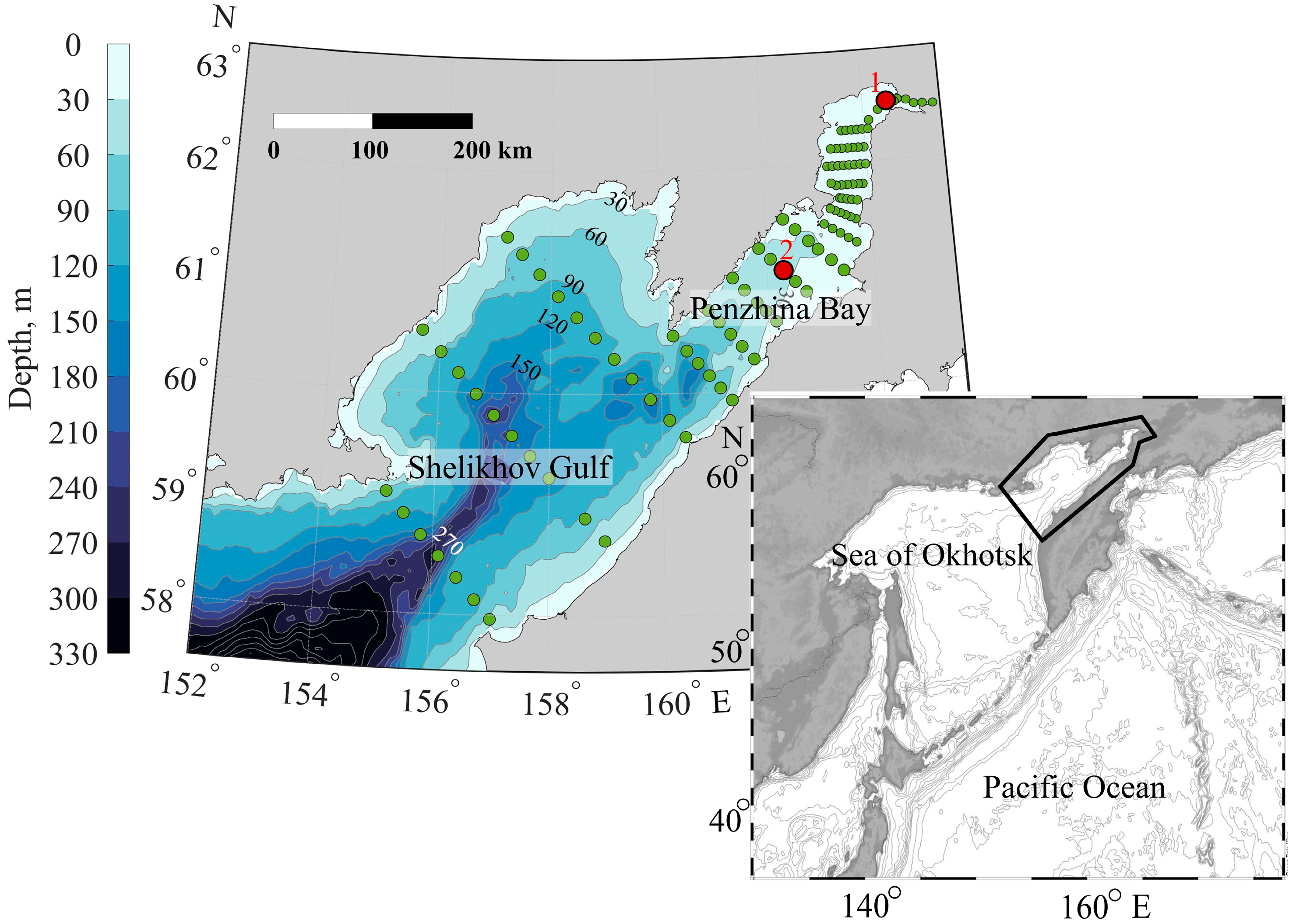
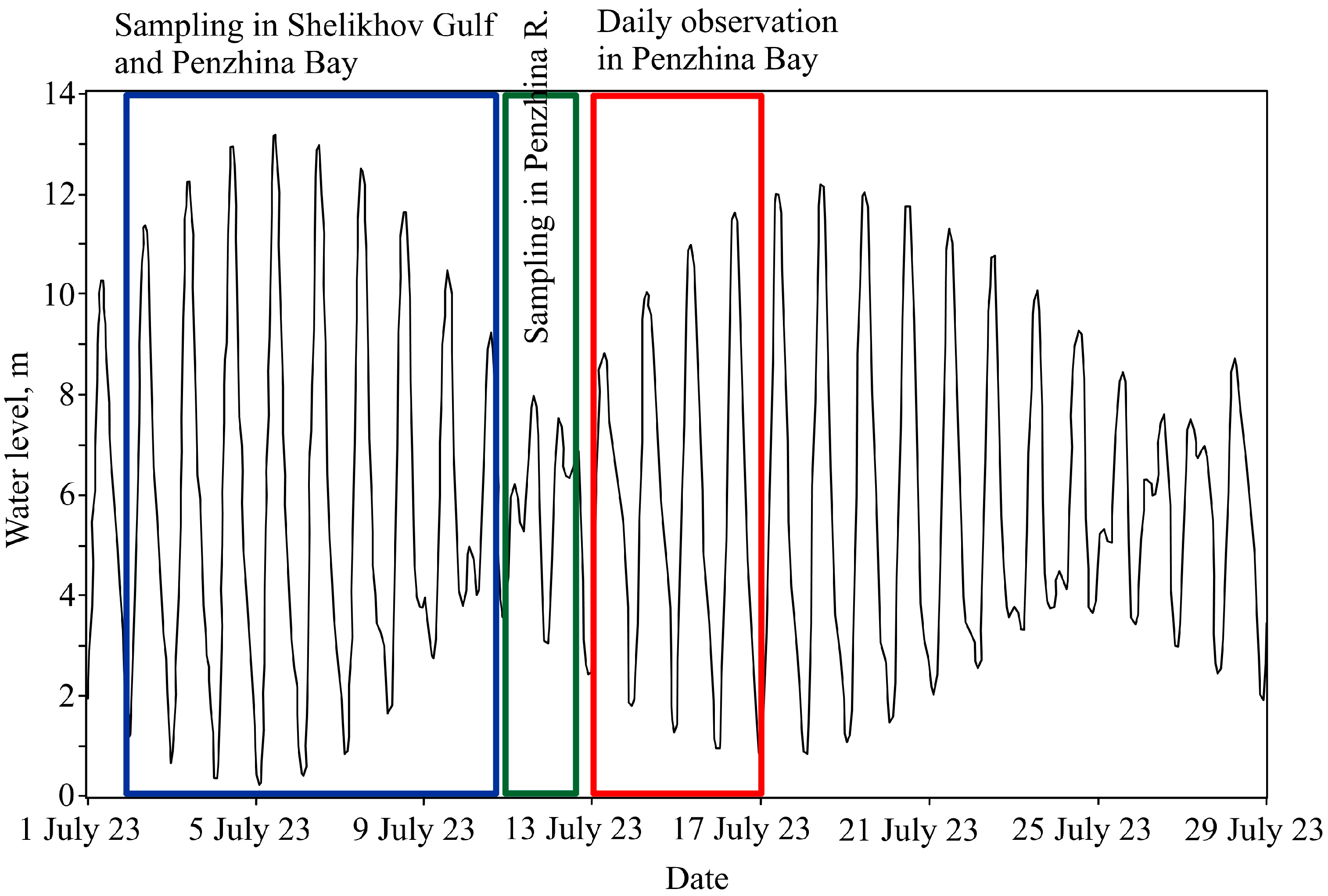
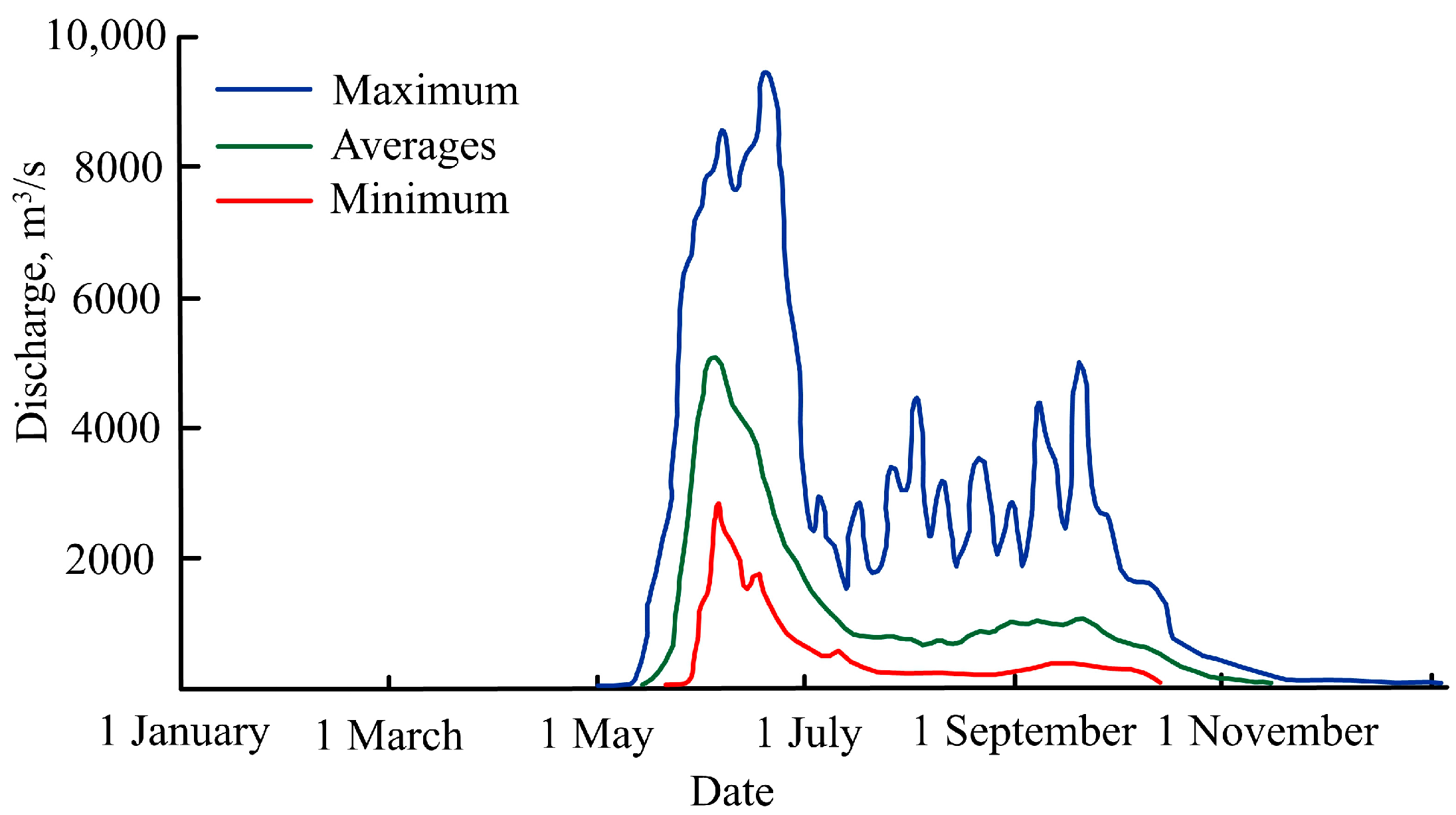
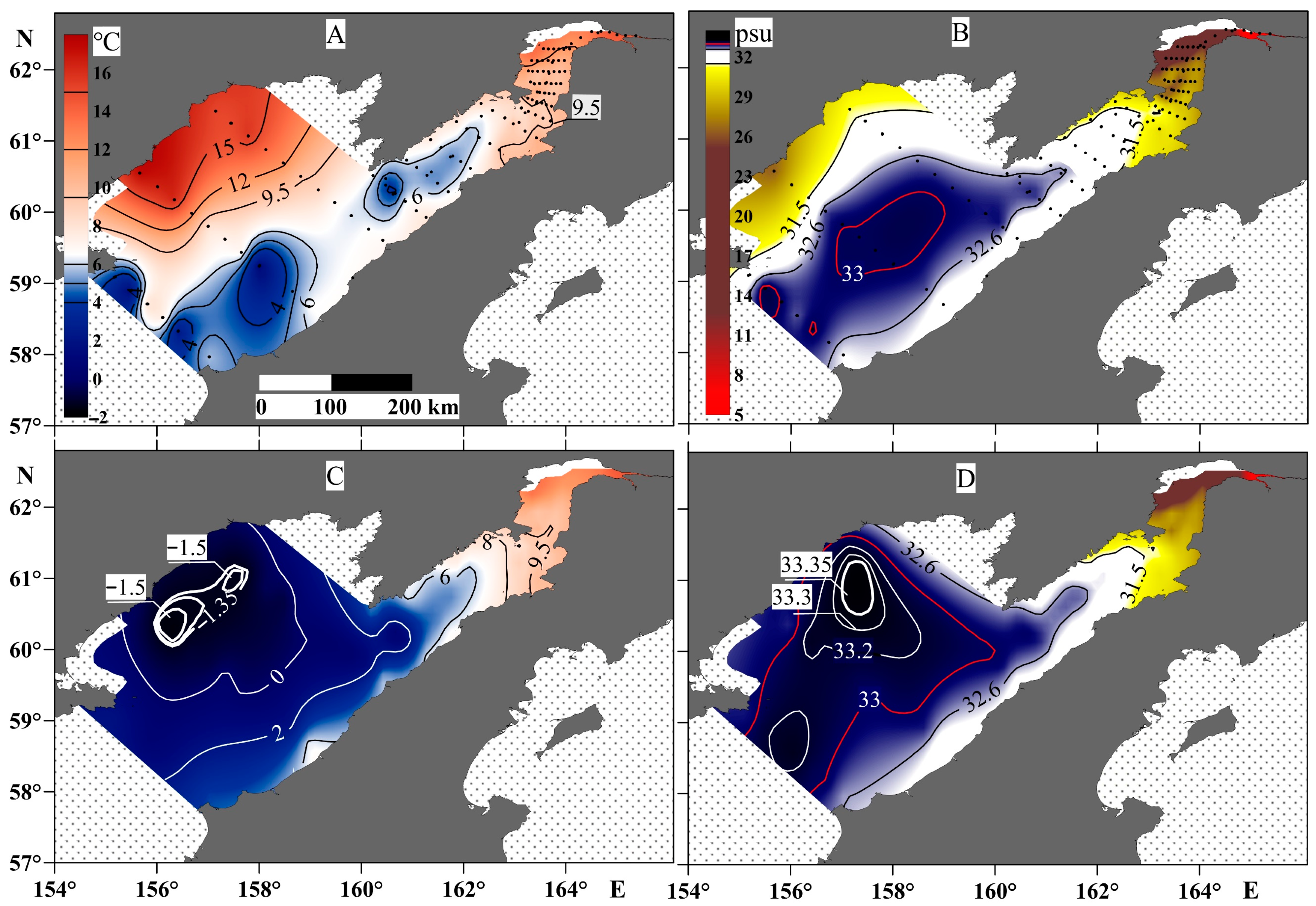
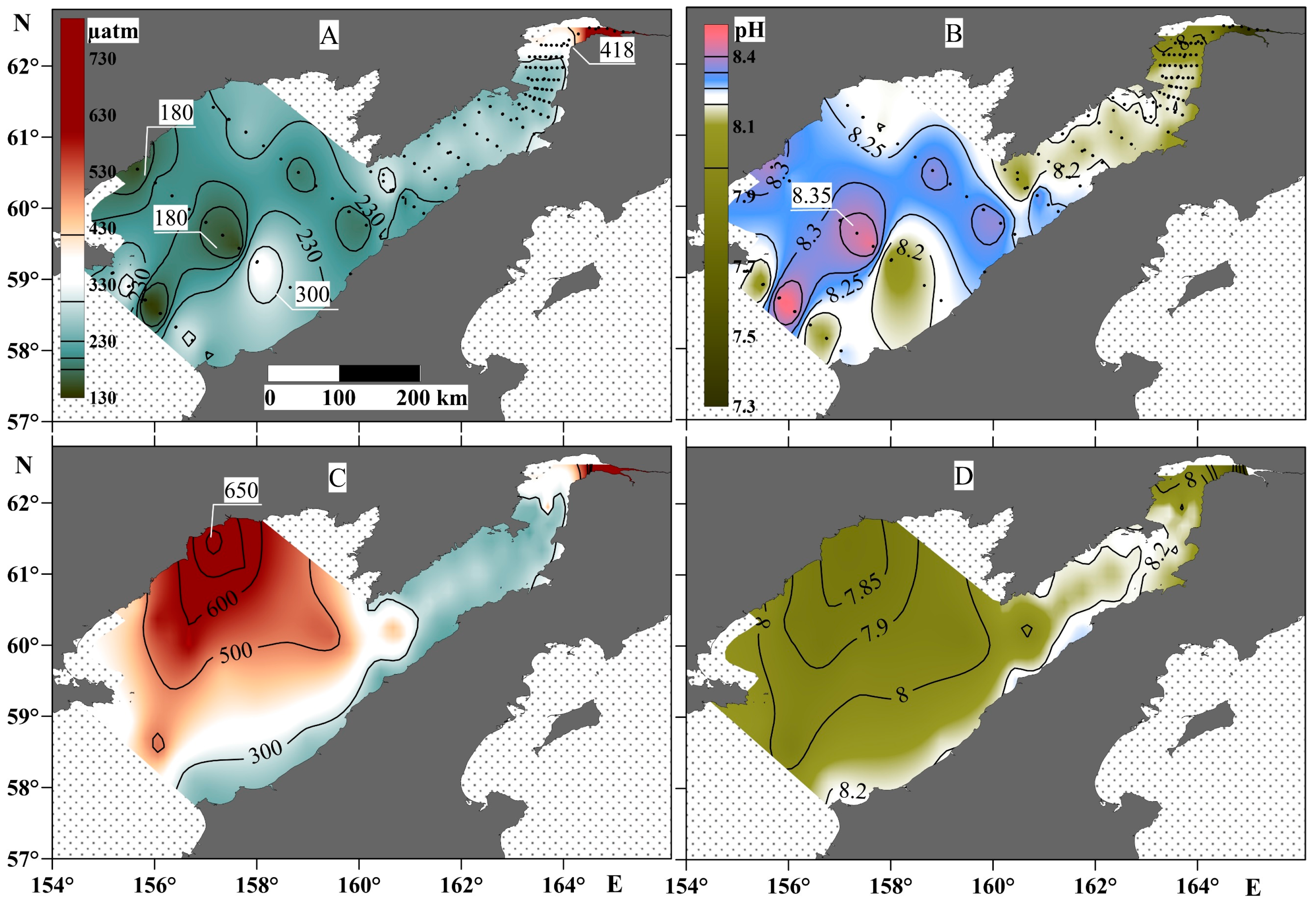
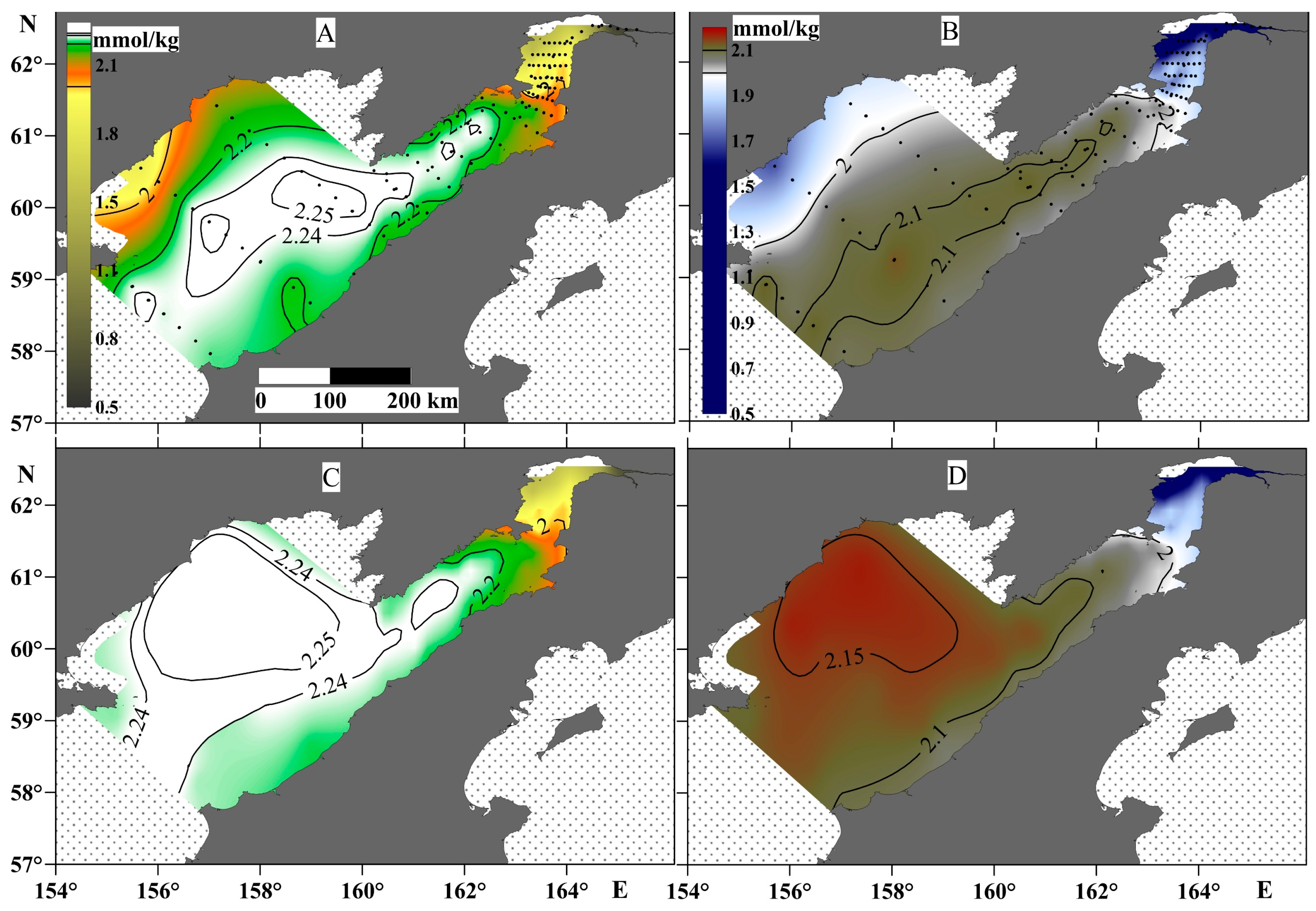

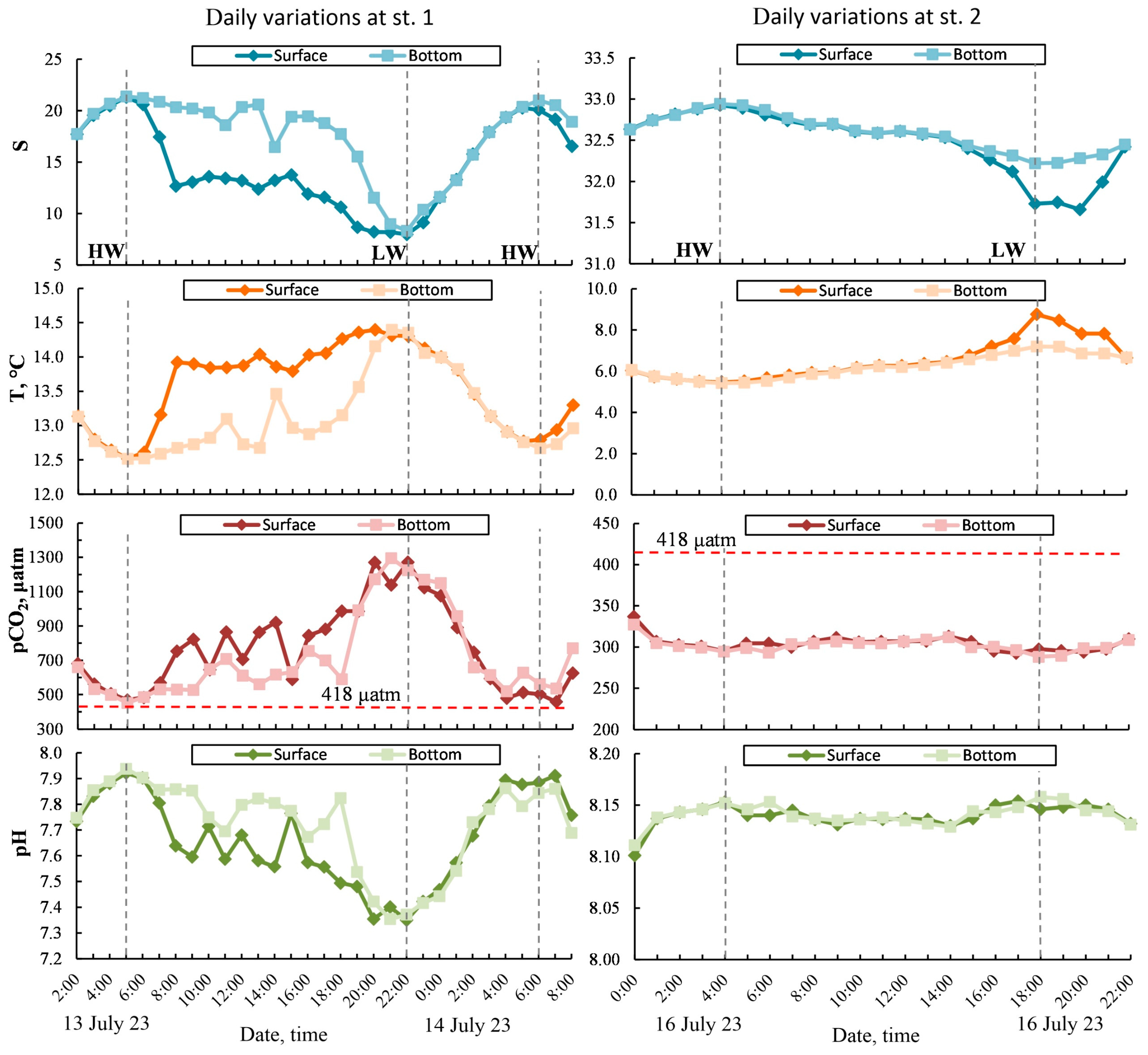

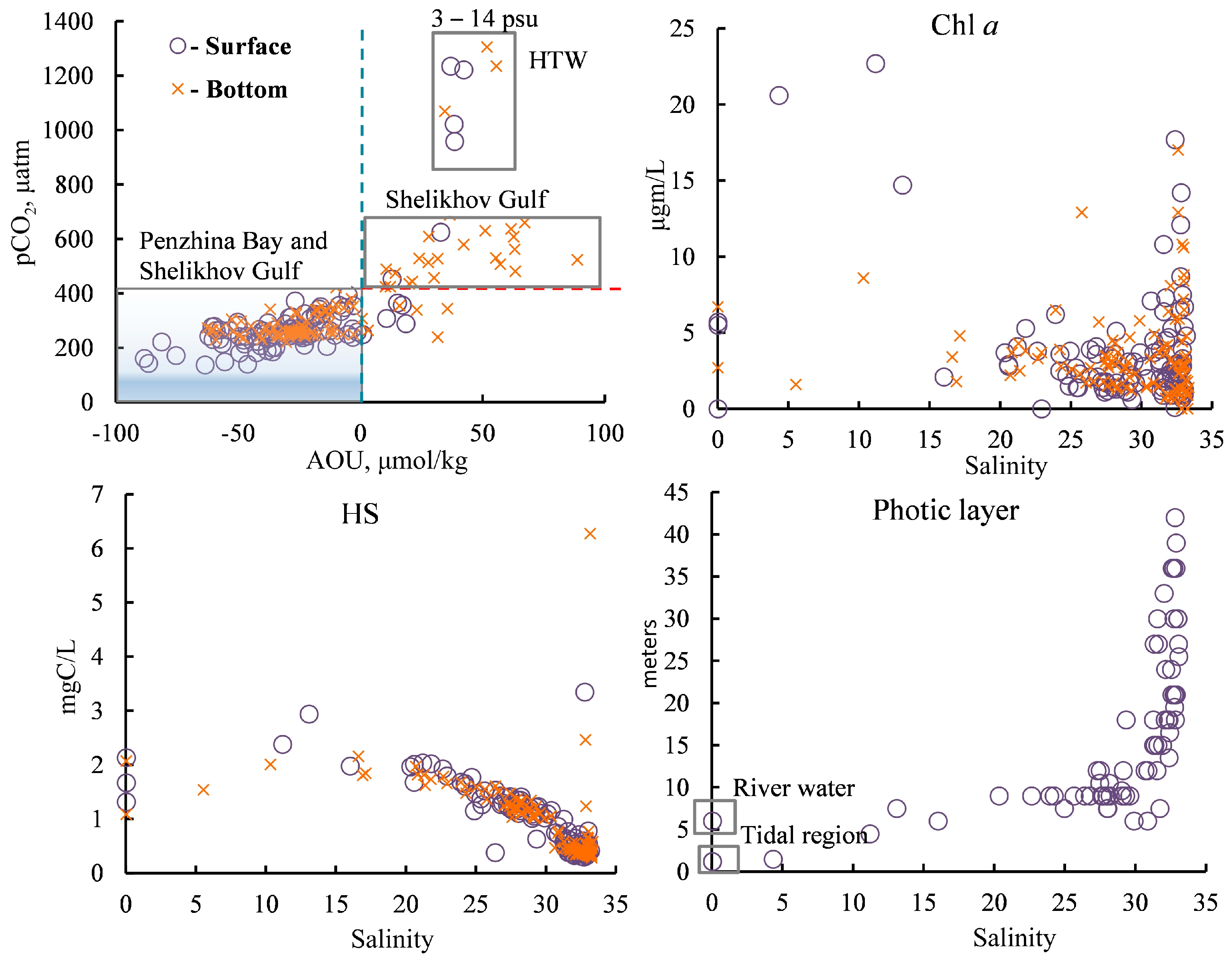
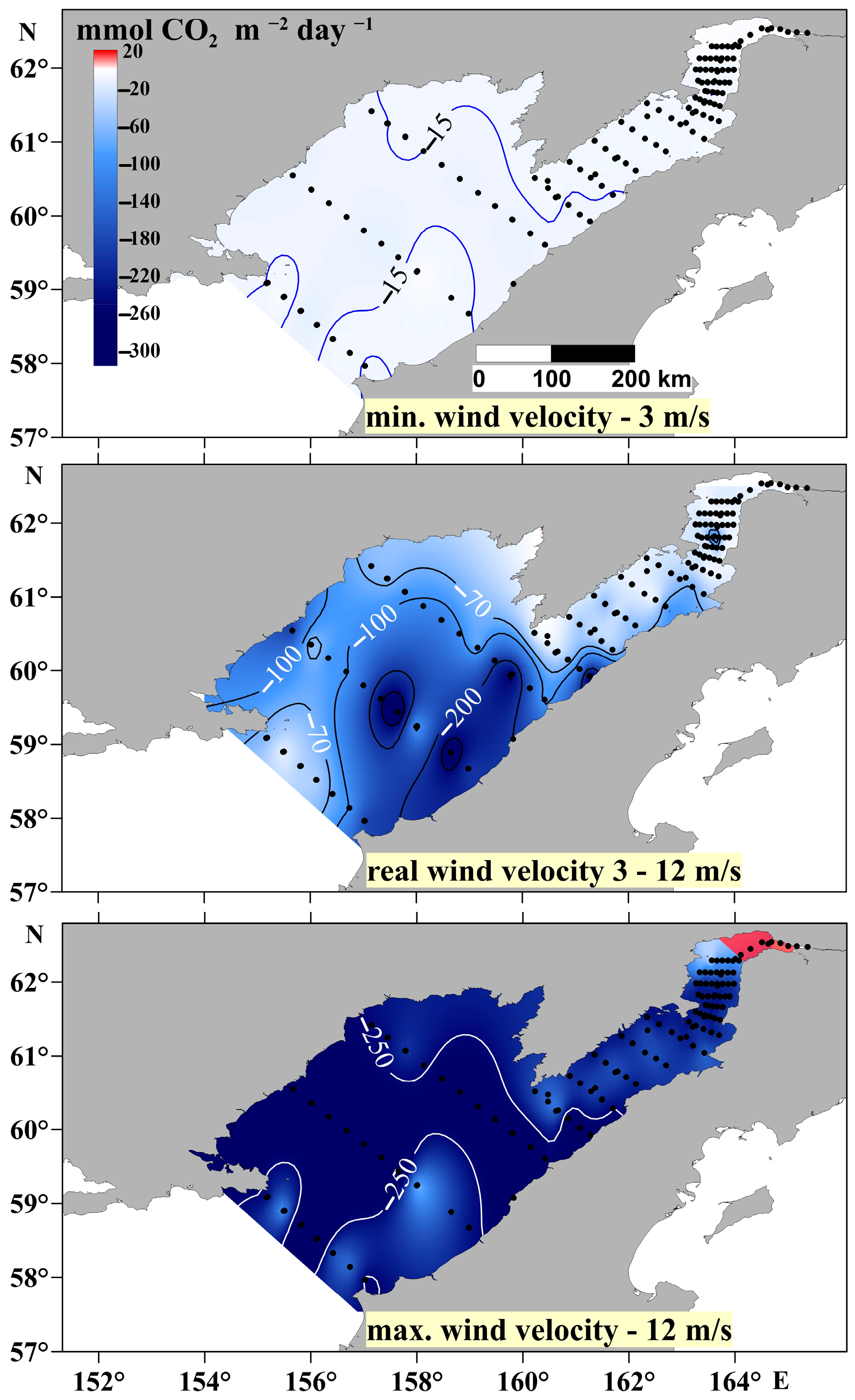
Disclaimer/Publisher’s Note: The statements, opinions and data contained in all publications are solely those of the individual author(s) and contributor(s) and not of MDPI and/or the editor(s). MDPI and/or the editor(s) disclaim responsibility for any injury to people or property resulting from any ideas, methods, instructions or products referred to in the content. |
© 2024 by the authors. Licensee MDPI, Basel, Switzerland. This article is an open access article distributed under the terms and conditions of the Creative Commons Attribution (CC BY) license (https://creativecommons.org/licenses/by/4.0/).
Share and Cite
Semkin, P.; Baigubekov, K.; Barabanshchikov, Y.; Gorin, S.; Koltunov, A.; Sagalaev, S.; Ulanova, O.; Tishchenko, P.; Shvetsova, M.; Shkirnikova, E.; et al. The Carbonate System of Penzhina Bay and the Shelikhov Gulf in the Sea of Okhotsk during Extreme Tides in Summer. J. Mar. Sci. Eng. 2024, 12, 517. https://doi.org/10.3390/jmse12030517
Semkin P, Baigubekov K, Barabanshchikov Y, Gorin S, Koltunov A, Sagalaev S, Ulanova O, Tishchenko P, Shvetsova M, Shkirnikova E, et al. The Carbonate System of Penzhina Bay and the Shelikhov Gulf in the Sea of Okhotsk during Extreme Tides in Summer. Journal of Marine Science and Engineering. 2024; 12(3):517. https://doi.org/10.3390/jmse12030517
Chicago/Turabian StyleSemkin, Pavel, Kirill Baigubekov, Yuri Barabanshchikov, Sergey Gorin, Alexey Koltunov, Sergey Sagalaev, Olga Ulanova, Petr Tishchenko, Maria Shvetsova, Elena Shkirnikova, and et al. 2024. "The Carbonate System of Penzhina Bay and the Shelikhov Gulf in the Sea of Okhotsk during Extreme Tides in Summer" Journal of Marine Science and Engineering 12, no. 3: 517. https://doi.org/10.3390/jmse12030517
APA StyleSemkin, P., Baigubekov, K., Barabanshchikov, Y., Gorin, S., Koltunov, A., Sagalaev, S., Ulanova, O., Tishchenko, P., Shvetsova, M., Shkirnikova, E., Tishchenko, P., & Zhang, J. (2024). The Carbonate System of Penzhina Bay and the Shelikhov Gulf in the Sea of Okhotsk during Extreme Tides in Summer. Journal of Marine Science and Engineering, 12(3), 517. https://doi.org/10.3390/jmse12030517





